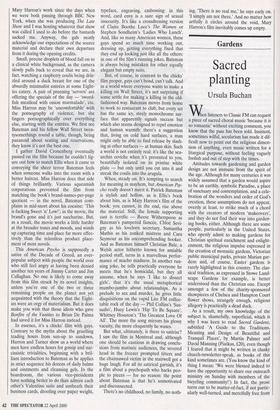Gardens
Sacred planting
Ursula Buchan
Wen listeners to Classic FM can request a piece of sacred choral music 'because it is so romantic' without exciting comment, you know that the pass has been sold. Insistent, sometimes wilful, secularism has made it dif- ficult now to point out the religious dimen- sion of anything, even music written for a liturgical purpose, without feeling vaguely foolish and out of step with the times.
Attitudes towards gardening and garden design are not immune from the spirit of the age. Although for many centuries it was widely assumed that a garden would aspire to be an earthly, symbolic Paradise, a place of sanctuary and contemplation, and a cele- bration of the wonders and order of God's creation, these assumptions do not appear, overtly at least, to strike much of a chord with the creators of modern 'makeovers', and they do not find their way into garden- ing books, either. Although there are some people, particularly in the United States, who openly admit to making gardens for Christian spiritual enrichment and enlight- enment, the religious impulse expressed in the creation of monastic gardens, Victorian public municipal parks, private Marian gar- dens and, of course, Easter gardens is rarely highlighted in this country. The clas- sical tradition, as expressed in Stowe Land- scape Gardens for example, is better understood than the Christian one. Except amongst a few of the charity-sponsored showpieces of Chelsea and Hampton Court flower shows, strangely enough, religious allegory is practically a dead duck.
As a result, my own knowledge of the subject is, shamefully, superficial, which is why I was keen to read Sacred Gardens, subtitled 'A Guide to the Traditions, Meaning and Design of Beautiful and Tranquil Places', by Martin Palmer and David Manning (Piatkus, £20), even though I feared that it might be written in clunky church-newsletter-speak, as books of this kind sometimes are. (You know the kind of thing I mean: 'We were blessed indeed to have the opportunity to share our outreach ministry on Sunday with members of the bicycling community!) In fact, the prose turns out to be matter-of-fact, if not partic- ularly well-turned, and mercifully free from soupiness, if not from exclamation marks! Martin Palmer is an expert on comparative religions, David Manning a heritage con- servationist, and both have been closely involved with the Living Churchyard Pro- ject, and the Sacred Land Project which promotes community gardens on once- derelict land.
The authors describe the meaning of sacred gardens from a number of faiths, including Islam, Taoism, Buddhism and Shintoism, as well as Christianity. I found the chapter on Japanese Buddhist and Shinto gardens especially fascinating, per- haps because there are so many Japanese gardens, both ersatz and genuine, in this country. Did you know that, in order to visit the Moss Temple Garden in Kyoto, you have to spend an hour or two reciting sutras before you are allowed in? That is something I should tell myself before I next go out in a grump to sweep up leaves. The foreword has been written by the Prince of Wales, a man whose gardening talents and spiritual strivings are well-docu- mented. He writes: 'The garden . . can become a glimpse of Paradise; a sacred space where humanity, nature and the Divine meet in harmony.' The word 'par- adise' was included in the promise that Christ made on the Cross to the repentant thief (`Today, thou shalt be with me in Par- adise') and it means 'walled pleasure gar- den' in Old Persian. It has, therefore, much meaning for followers of Islam, too. The book surveys, briefly, a number of public Paradise gardens, such as the Alhambra in Granada, as well as others from the major religious traditions.
The authors also point out those plants which have in the past had more than just aesthetic meaning in the garden, and are easily grown, such as the Madonna lily, the burning bush (Dictamnus), Glastonbury thorn, lily-of-the-valley, St John's wort, angelica, elderberry and fig. They describe how to make a number of different sacred gardens, and what plants to use for them. Even without going so far as that, it is still possible to recognise that a garden any garden — is a place where eternal truths and mysteries, beyond ourselves, are most easily pondered; that solitude in the open air is a positive virtue and an aid to contemplation, even healing, which should be sought more earnestly than those false gods of Relaxation and Leisure; and that physical labour can be uplifting — well, sometimes, anyway. As Kipling put it: 'The Glory of the Garden glorifieth everyone.' A Catholic friend of mine once told me that she was required to write at the top of her school essays the letters AMDG — 'Ad majorem Dei gloriam ' — to remind her of the purpose of everything she did, however mundane. What goes for an analysis of the balance of power between monarchy and nobility in early Tudor England must surely apply also to the care of a garden. I shall think of that tomorrow on the annual ritual trip to the garden centre.



























































 Previous page
Previous page